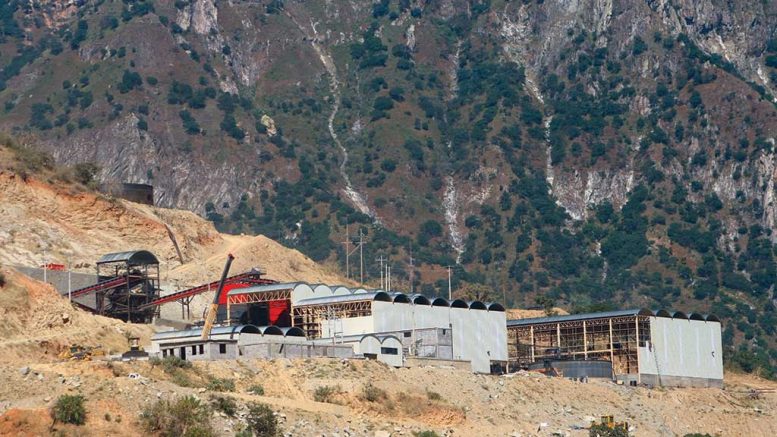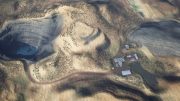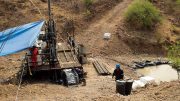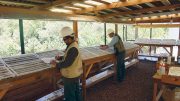It’s not often that a mining company releases three preliminary economic assessments on three different mines in two months.
But that’s what Sierra Metals (TSX: SMT; NYSE-AM: SMTS) accomplished in June and July when it completed studies on expanding output at its two mines in Mexico — Bolivar and Cusi — and at a third mine, Yauricocha, in Peru.
In Mexico, the two mines are situated in the state of Chihuahua.
Bolivar, an underground copper-silver-gold mine, 400 km south of Chihuahua, started commercial production in November 2011 and has reserves for a seven-year mine life.
Cusi, a silver-lead-zinc-gold underground mine, 135 km southwest of Chihuahua, started commercial production in January 2013, although it is still considered in the development stage, as most production comes from development rock.
In the three months ended June 30, Bolivar produced 4.74 million lb. copper, 110,000 oz. silver and 911 oz. gold, while Cusi produced 190,000 oz. silver, 287,000 lb. lead and 96 oz. gold.
The PEA Sierra released on Bolivar in July evaluated how the mining operation could be adapted to lift mine production and mill throughput from 3,000 tonnes per day to 3,600 tonnes per day by March 2019, and subsequently to 5,000 tonnes per day by mid-2020, based on current metal prices.
The Piedras Verdes plant, 5.1 km from Bolivar, uses a conventional crushing-milling-flotation circuit to recover minerals and produce copper concentrates with silver and gold by-product credits.
The current tailings storage facility has the capacity to store tailings until the end of 2019.
The PEA outlines life-of-mine capex of US$96 million that includes building a much larger tailings facility.
The base case in the study uses metal prices of US$1,291 per oz. gold, US$18.25 per oz. silver and US$3 per lb. copper, and calculates a net present value at an 8% after-tax discount rate of US$214 million for an anticipated 550% return on investment and a less than three-and-a-half-year payback period.
Life-of-mine metal production over an 11-year mine life is expected to be 86,472 oz. gold, 7.01 million oz. silver and 114,537 tonnes copper.
The study is based on mineral resources as of July 5 — excluding drilling after that date. Sierra continues to conduct brownfield exploration programs and expects to grow the resource this year.

Sierra Metals’ Cusi silver-lead-zinc-gold mine in Chihuahua, Mexico. Credit: Sierra Metals.
Bolivar has indicated resources of 13.3 million tonnes grading 23 grams silver per tonne, 1.04% copper and 0.30 gram gold per tonne for a 1.37% copper-equivalent grade of 402 million lb. copper-equivalent.
Probable reserves measure 7.93 million tonnes grading 19 grams silver, 0.86% copper and 0.25 gram gold for a 1.14% copper-equivalent grade and contained metal of 199 million lb. copper equivalent.
At Sierra’s Cusi mine, meanwhile, a PEA completed in June examined increasing mill throughput from the current 650 tonnes per day to 1,200 tonnes per day by the end of the first quarter of 2019, and then boosting that to 2,700 tonnes per day in 2021.
The Mal Paso plant, 44 km from Cusi, is a conventional crushing-milling-flotation circuit, like the mill at Bolivar. It produces lead-silver and zinc concentrates.
The PEA assessed raising Mal Paso’s processing capacity to 1,200 tonnes per day in 2019 and building a new plant closer to the mine at Cusihuiriachi, with a capacity of 1,500 tonnes per day, which would come online by mid-2021.
The PEA determined that mechanized bench-and-fill mining could help achieve sustainable production of 2,700 tonnes per day. Head grades would fall from the current 201 grams silver per tonne to 161 grams silver at a run-rate of 1,200 tonnes per day, and drop to 145 grams silver per tonne at a processing rate of 2,700 tonnes per day.
In addition, the company plans to increase raises at the existing tailings facility that will provide another 520,000 cubic metres of storage capacity — or 19 months of storage capacity.
Sierra is also evaluating nine other sites for their potential to store more tailings.
Using metal prices of US$1,283 per oz. gold, US$18.30 oz. silver, US93¢ per lb. lead and US$1.15 per lb. zinc, the Cusi PEA outlines an after-tax NPV at an 8% discount rate of US$92.2 million and a 75% post-tax internal rate of return.
The study envisions a nine-year mine life. Life-of-mine capital costs of US$104.5 million could be paid back, after-tax, in just over four and a half years.
The Cusi PEA is based on a February 2018 resource estimate and does not incorporate later drilling.
Measured and indicated resources stand at 4.56 million tonnes grading 218 grams silver, 0.63% lead, 0.665 zinc and 0.20 gram gold for a silver-equivalent grade of 267.20 grams per tonne for contained metal of 39 million oz. silver-equivalent. Inferred resources add 1.63 million tonnes grading 158 grams silver, 0.54% lead, 0.84% zinc and 0.16 gram gold for a silver-equivalent grade of 207 grams per tonne and contained metal of 11 million oz. silver-equivalent.
In August, Sierra reported financial results for the three months ended June 30, recording a 29% year-on-year increase in revenues to US$62.7 million, a 64% increase in adjusted earnings before interest, taxes, depreciation and amortization to US$28.9 million (a record for the company), and a 70% jump in operating cash flows before movements in working capital of US$29.5 million.
Sierra closed the quarter with US$21.8 million in cash and equivalents and US$15 million in available credit facilities.

The flotation plant at Sierra Metals’ Bolivar copper-silver-gold mine. Credit: Sierra Metals.
Igor Gonzales, Sierra Metals’ president and CEO, told analysts and investors on a conference call that the company “continues to see positive gains and momentum from the progress of the operational turnaround programs implemented in Mexico.”
“Bolivar realized a 41% increase in throughput, with a 45% increase in copper-equivalent production, while Cusi realized a 95% increase in throughput, with a 46% increase in silver-equivalent production in the second quarter of 2018, compared to the second quarter of 2017,” he notes. “We continue to modernize operations, improving production and lowering costs, with further benefits expected to continue in the third quarter and beyond.”
Improvements include new mining equipment purchases that allow more mineable stopes in the mine plan at Bolivar and a change in focus at Cusi from existing narrow vein structures to the Santa Rosa de Lima Zone, which has larger widths and higher grades.
Revenue at Bolivar increased 61% year-on-year, as the mine reached a throughput rate of 3,100 tonnes per day during the quarter.
Revenue at Cusi jumped 102% higher than the comparative quarter in 2017.
In a separate interview with The Northern Miner, Gonzales said “both mines are on budget now and hitting the production rates they should,” since the operational turnaround started a year ago. “Recoveries are improving and management has been upgraded, and we’re trying to mechanize both mines.
“In the past, we couldn’t meet our production targets. We were up and down, up and down, and we didn’t have a good grasp of production, it fluctuated too much … so our turnaround program has been successful.”
Gordon Babcock, the company’s chief operating officer, noted on the conference call that the company has also made “huge improvements” in the tailings management system at Bolivar, “using a process that uses a little bit of creativity in handling the slurry tails.
“We’re using cells or ponds, dewatering the slurry, then accessing the deposition of the new dewatered tail similar to a dry stack, so this is working quite well, we’re controlling a great deal of production in this fashion.”
On the exploration front in the second quarter, Sierra drilled 7,400 metres at Bolivar, of which 2,000 metres were drilled in the El Gallo zone and 5,400 metres of drilling from surface was divided between Bolivar Northwest, Bolivar West and Cieneguita.
The drilling is designed to explore the extension of the orebody to the north and west, exploring the skarn orebody with semi-massive magnetite, and disseminated nodules of chalcopyrite.
There are also greenfield exploration targets to analyze geological anomalies and the continuity of the orebody to the west.
At Cusi, 10,400 metres were drilled during the quarter to verify the continuity of the orebody and develop veins. Of that, 1,000 metres were drilled inside the mine to verify orebody continuity and develop veins, and 9,400 metres were drilled from surface.
Another 1,700 metres of development was related to the extension of the main ramp to the Santa Rosa de Lima zone, as the company continues to prepare stopes for mining.
“We have a very aggressive exploration program at both sites,” Gonzales says. “We’re spending more capital than we used to in the past, and this is providing good results … we need to continue these efforts to increase our resource base.”
As a jurisdiction, Gonzales says, and like any country, Mexico has pros and cons. On the plus side, he notes, permitting is “pretty straightforward in terms of regulatory requirements,” and is “less bureaucratic” than in many other places.
“We normally get our permits on time.”
And while Mexico is often equated with violent crime and poor security, the company has not experienced any problems at either site. Cusi, he says, is close to a major population centre (Cuauhtemoc) and just an hour’s drive from Chihuahua. “When we go to the mine we don’t have any security personnel because it’s a very, very safe location,” he says. “It’s in an agricultural area and very quiet.”
At Bolivar, which is in the highlands of the Sierra Madre, it’s a bit more challenging, but Gonzales says the mine doesn’t require extra security, police or the army — although the army does rounds in the district every 45 days.
“We haven’t had any issues with security at Bolivar, and we think that one of the main reasons is because we work with the local community, which provides services for the mine, in terms of transportation of ore and concentrates. We partner with the local community. They are contractors to us and that keeps a very good working relationship.”
As for the presidential election in July of left-leaning veteran politician Andres Manual Lopez Obrador of the National Regeneration Movement, Gonzales sees no signs of any changes in the status quo.
“At the local level, we haven’t seen any changes since the election in the agencies or attitudes, or any regulatory things, none whatsoever,” he says.
“He knows he has to promote investment, and mining, of course, is an important piece of the Mexican economy.”





Be the first to comment on "Sierra Metals executes turnaround plan"